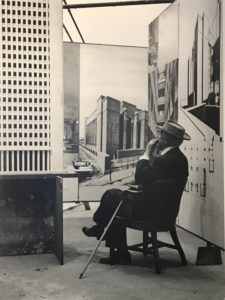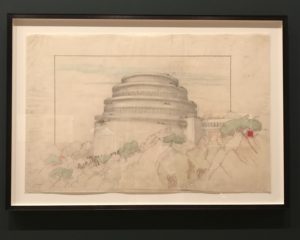MoMA’s Version of a Birthday Party: “Frank Lloyd Wright at 150: Unpacking the Archive”

The Museum of Modern Art, MoMA, is hosting a major career retrospective on architect Frank Lloyd Wright to commemorate 150 years since his birth. Wright’s 150th birthday would have been June 8th, 2017, thus this exhibition which runs from June 12th to October 1st, 2017 is the perfect time to display the Wright archives. Many of these objects are being shown for the first time. The museum, in conjunction with Columbia University, acquired the archive about five years ago, consisting of numerous drawings, photographs, architectural models, video footage, and more. Hosting this retrospective in New York City is important in celebrating a crucial figure involved in both the development of architectural practice and design as well as the evolution of New York City’s buildings and skyline. It yields Wright the recognition and admiration that his genius deserved, and captures all of the ventures and major projects of what was such a long career. Yet, this exhibition didn’t quite capture the spirit and the atmosphere of his remarkable spaces.
This showing of approximately 450 items, curated by Barry Bergdoll, is divided throughout twelve galleries each with their own specific themes such as Ecologies & Landscapes, Drawing in the Studio, and Circular Geometries. The clear organization and grouping of sub-topics throughout the galleries correlated to the chronological order and progression from Wright’s earliest projects and first exhibition in 1932, to his late-life projects and retrospectives. The introduction to the show outside the first gallery states, “Wright was not only a master architect but also a master draftsman, creating documents that could translate his ideas into built form and present possible future designs” as Wright was not always executing his own ideas and models but made such detailed and sophisticated plans that it was easy for others to interpret and execute them.
In returning to the title of this exhibition, “Frank Lloyd Wright at 150: Unpacking the Archive,” I applaud Bergedoll’s choice to simply “unpack” the works as the title says, and not do too much in trying to illustrate a certain viewpoint or angle about Wright’s capabilities. As they navigate through the galleries, viewers are able to do with this what they wish and take away as much or as little as they so chose, with out feeling a certain opinion was forced upon them. I see how visitors could have easily either formed a connection with these items and this architect or easily walked out with no feeling or emotional attachment to what they just saw and experienced. Yet at the same time MoMA is clearly celebrating his contributions to the field and continuing his impactful legacy.
Bergedoll employed curatorial skills that really enhanced this exhibition such as the use of some deep blue walls in contrast to the usual stark white gallery walls to keep viewers engaged with dense material. Also, I found the videos to be crucial to the exhibition as a whole, and thoughtfully placed, because they provided a break from studying such meticulous and mathematical drawings and engaged visitors’ audio senses periodically. Bergedoll wrote, “this footage, some of which is excerpted from home movies, reveals something of how Wright personally engaged with his students, family, and friends in an intimate environment that was as much a home as it was an architecture studio,” humanizing Wright and showcasing him as more than just an architect.
The building plans and designs made public in this exhibition are captivating because I had never seen or even heard of many of Wright’s international projects such as those intended for Tokyo. Plus, the three dimensional models scattered throughout the galleries are essential in visitors’ grasping of this information because they can walk around the models and fully realize what the one dimensional plans and drawings translate into. I see how this exhibition could be awe-inspiring to students or even other architects living in the greater NYC area who were able to view the show and objects not often available for public viewing.

Living in and loving NYC made it easier to appreciate and relish in the works shown in this exhibition because they felt close to home literally and figuratively since here in New York we can witness his excellence daily. Bergedoll draws light to what exactly went into creating NYC’s beloved Guggenheim, a cultural staple of this city. This serves as a wakeup call to viewers who may have for the first time been invited to contemplate what really goes into creating the iconic NYC structures and thus the beauty of NYC in addition to the other towns and cities across America that house a building designed by Wright.
Conversely, at the same time I found 450 objects under one roof to be slightly overloaded and overwhelming. The selection of works from the archive that were chosen for display here were rather heavy on the drawings. Even though I appreciated the exhibition and I was pleased that MoMA chose to honor an architect, an often less emphasized category of fine art, I would not put this show in my top five greatest exhibitions ever attended. I didn’t gather much emotional attachment and it was an exhibition that required too much intense focus in my opinion. The sheer volume of images and text to process here was not working for me.
I do understand that it may be difficult to present architectural material in the museum context, removed from the actual structures and the sensations that are inspired by being in the physical spaces. Although in another light, visitors may be inspired afterwards to go visit spaces Wright designed and experience his ingenuity themselves, thus facilitating more positive interaction with Wright’s work and the field of architecture as a whole. As this exhibition closes soon, October 1, I recommend seeing it and commenting with feedback and reactions of your own!